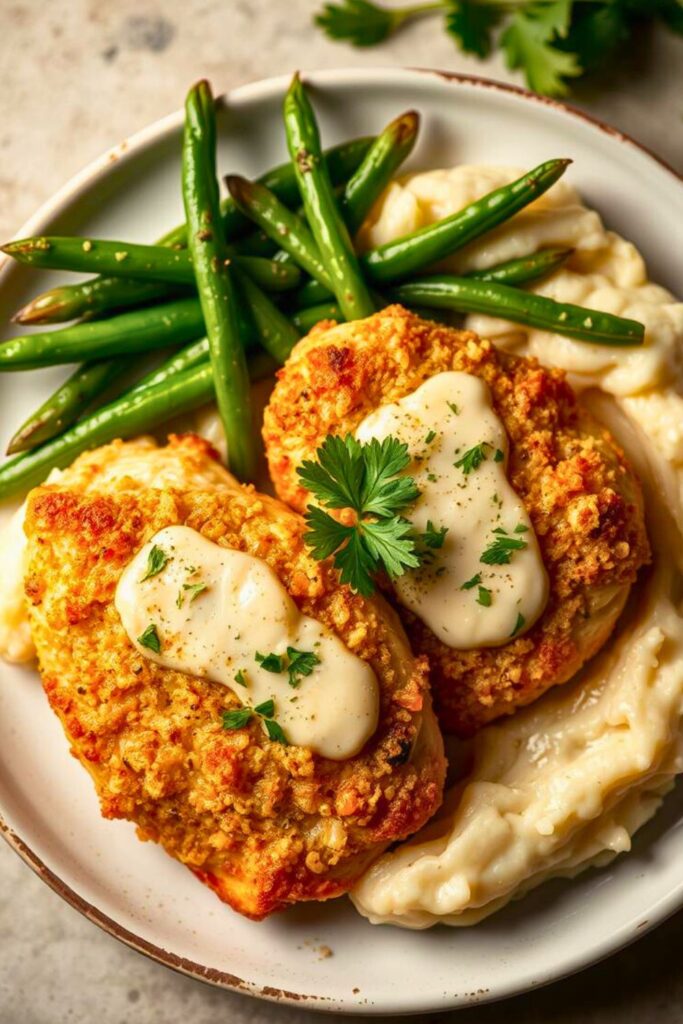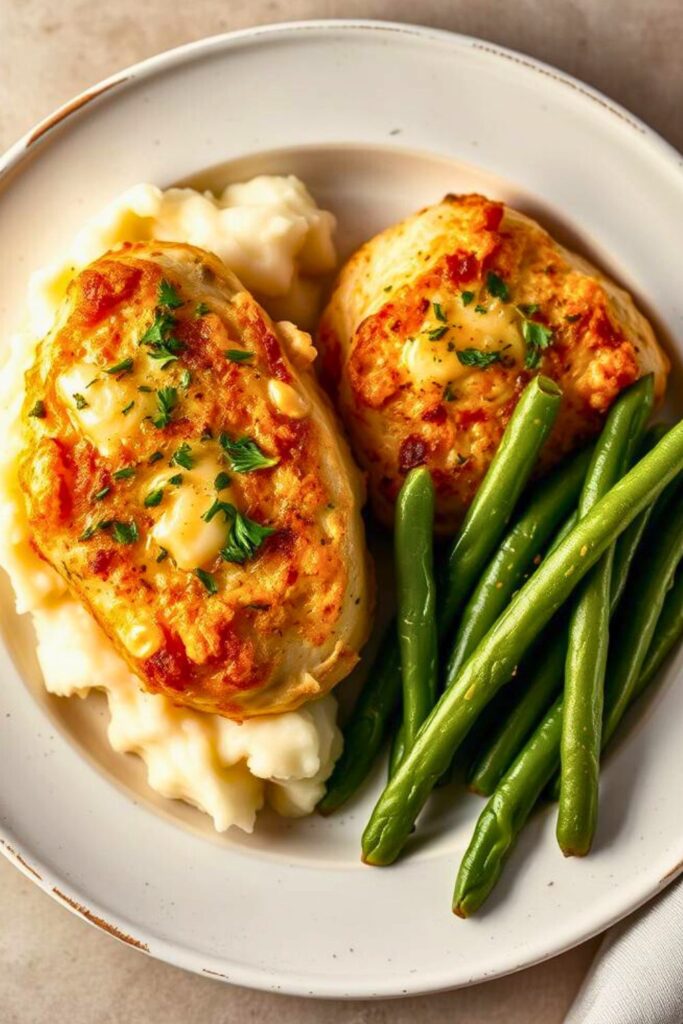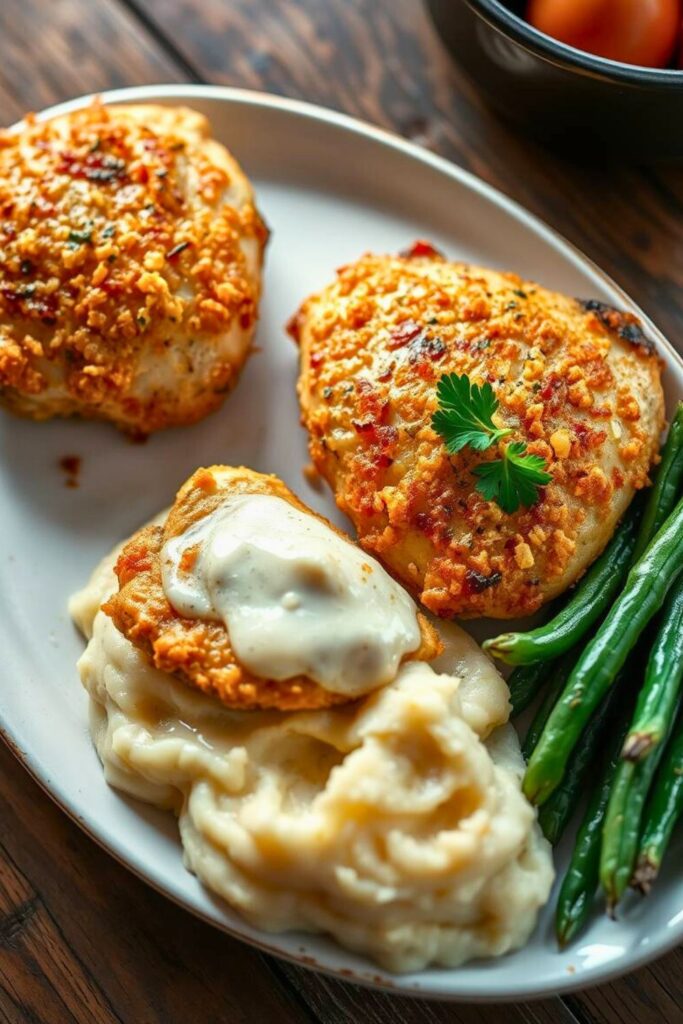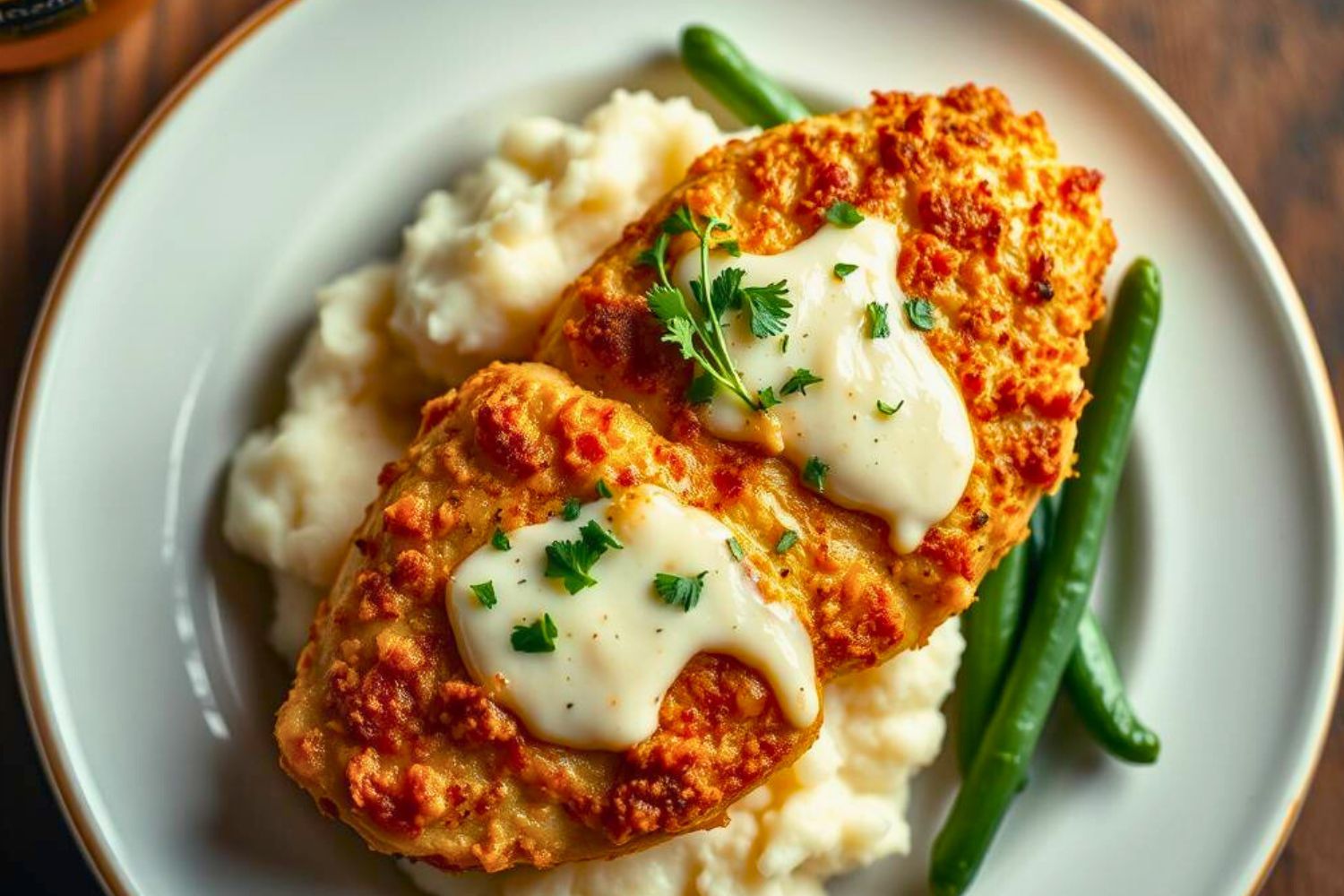Picture this: you slice into golden chicken breast, your knife glides through like warm butter. The first bite dissolves on your tongue. Layers of flavor make your eyes flutter closed.
That’s what happens when you master truly tender chicken. I’m about to share every secret that’ll get you there.
Most people think chicken’s just chicken. They settle for dry, chewy protein drowning in sauce. But here’s what changed everything for me: chicken becomes transcendent when you treat it right.
This Melt In Your Mouth Chicken isn’t just another recipe. It’s your ticket to becoming the dinner hero. The technique I’ll share transforms ordinary chicken into something so tender people ask for your secret.
The best part? It’s way easier than you think.
What Makes This Chicken Different
Let me tell you what sets this apart. It’s not one magic trick; it’s smart techniques working together.
First, we brine that chicken properly. Not the overnight marathon that intimidates everyone. A quick 30-minute salt bath does wonders.
Then comes the real game changer: gentle poaching that keeps protein from seizing up. The result? Melt In Your Mouth Chicken, you’ll cut it with a fork. Every bite releases incredible flavors. You’ll never cook chicken another way again.
Why This Method Works Every Time

Here’s the thing about chicken, you control temperature and moisture. Most recipes blast chicken with high heat. That’s exactly how you create shoe leather.
This technique does the opposite. We treat that chicken like delicate protein. Think cashmere sweater, you wouldn’t blast it hot.
You control temperature and keep muscle fibers relaxed. No violent bubbling. No scorching heat. Just controlled, even cooking that guarantees Melt In Your Mouth Chicken every time.
The Secret Ingredients That Transform Everything
Let’s talk about what goes into making this melt in your mouth chicken extraordinary. These aren’t exotic ingredients, they’re smart choices that amplify flavor and tenderness.
For the Brine:
- 4 cups warm water
- 3 tablespoons kosher salt
- 2 tablespoons brown sugar
- 1 bay leaf
- 2 garlic cloves, smashed
For the Chicken:
- 4 boneless, skinless chicken breasts (6-8 oz each)
- 2 cups low sodium chicken broth
- 1 cup dry white wine (or more broth)
- 2 tablespoons olive oil
- 1 medium onion, sliced thin
- 3 garlic cloves, minced
- 2 sprigs fresh thyme
- 1 bay leaf
- Salt and freshly cracked black pepper
For the Finishing Touch:
- 2 tablespoons butter
- 1 tablespoon fresh lemon juice
- 2 tablespoons fresh herbs (parsley, chives, or thyme)
Smart Swaps That Save the Day
Your pantry doesn’t look like mine, and that’s fine. Here’s how to make this work with what you’ve got.
No white wine? Use extra chicken broth instead. Try apple cider vinegar for acidic brightness. Fresh herbs cost a fortune? Dried works, use half the amount and add them earlier.
See also: Chili Crisp Chicken Mango Cucumber Rice Bowl
Can’t find kosher salt? Regular table salt works fine. Use 25% less since it’s more concentrated. Brown sugar running low? White sugar works, or try honey.
Here’s a pro tip: those massive grocery store breasts could feed small villages. Slice them horizontally into thinner cutlets. They’ll cook evenly, absorb flavors better, and get you one step closer to Melt In Your Mouth Chicken every single time.
Step by Step Magic That Works
Let’s walk through this together. I’ll tell you exactly what to look for at each step. Plus those little tricks that prevent disasters.
Getting the Brine Right
Dissolve salt and sugar in warm water. Don’t skip brown sugar, it’s not just for sweetness. That sugar helps chicken hold moisture during cooking.
Add bay leaf and smashed garlic. Let everything cool to room temperature. Hot brine starts cooking your chicken early. We don’t want that.
Submerge chicken completely for 30 minutes. Not longer, we’re not making jerky. Just long enough for salt to work magic on protein structure.
The Poaching Process That Changes Everything
Most people treat chicken like it’s trying to escape. We’ll be gentle here. We’re coaxing it into tenderness, not forcing it.
Heat olive oil in wide, heavy bottomed pan over medium heat. Sauté onions until golden and sweet, about 5 minutes. This creates flavorful base that makes chicken sing.
Add garlic, cook until fragrant, maybe 30 seconds. Don’t let it brown or it turns bitter.
Now the crucial part: add broth and wine. Bring to gentle simmer, then slide in brined chicken. Liquid should barely cover meat. Need more? Add extra broth.
The Temperature Game That Guarantees Success
Here’s where people mess up constantly. They think simmering means rolling boil. Then wonder why chicken turned into rubber bands.
You want tiny bubbles breaking the surface. Think lazy Sunday morning, not Monday rush. Bubbling aggressively? Turn that heat down.
Cover the pan, cook 15-18 minutes depending on thickness. Don’t lift that lid constantly, you’re releasing steam. Trust the process.
Chicken’s done at 165°F internal temperature. Chef secret: it feels firm but gives slightly when pressed. Overcooked chicken feels like pressing tennis balls.
The Science Behind Why This Works
Let me geek out about what’s happening in that pan. Understanding why makes you better every time.
When you brine chicken, you do two amazing things. Brined chicken benefits from salt breaking down tough protein structures, creating gaps that hold moisture. It seasons meat all the way through, not just surface, the secret to moist chicken and flavor packed bites.
Gentle chicken poaching technique keeps muscle fibers from contracting violently. That’s what squeezes out juice. High heat makes proteins seize up like tiny chicken crunches. Low, slow heat keeps everything relaxed, exactly what gives you tender chicken and juicy chicken.
That wine acid breaks down connective tissue too. Another tenderness layer. It’s like giving chicken a spa day instead of boot camp, the science behind true Melt In Your Mouth Chicken.
Why Your Pan Choice Matters
Use heavy bottomed pan if you’ve got one. It distributes heat evenly. No hot spots that overcook some parts while others lag behind.
Wide pan works better than tall, narrow ones. Gives each chicken piece room to cook evenly. Crowded chicken is sad chicken, it steams instead of poaching.
Cast iron, stainless steel, or enameled Dutch ovens work beautifully. Avoid thin, lightweight pans that create hot spots.
Making It Restaurant Worthy

Don’t just slap cooked chicken on plates. Simple touches turn this into fancy restaurant fare.
Let chicken rest 5 minutes after cooking. Juices redistribute instead of running everywhere. Meanwhile, strain cooking liquid, reduce by half over medium high heat.
Whisk in cold butter for glossy, restaurant style pan sauce. Lemon juice brightens everything, cuts through richness perfectly.
Perfect Pairings That Complete the Meal
This tender chicken plays beautifully with many flavors. Creamy mashed potatoes soak up gorgeous pan sauce. Roasted vegetables add color and texture contrast.
For wine, try crisp Sauvignon Blanc or light Pinot Noir. Acidity complements richness without overwhelming delicate chicken flavor.
Rice pilaf, buttery noodles, crusty bread for sopping sauce, you can’t go wrong. Chicken’s so flavorful it makes everything taste better.
Troubleshooting Your Melt in Your Mouth Chicken
Sometimes things don’t go exactly as planned. Here’s how to fix common issues before they become disasters.
Chicken feels tough? You probably cooked too fast or too long. Next time, keep heat lower, trust your thermometer over clock. Every chicken piece is different.
Bland chicken usually means you skipped brine or didn’t season cooking liquid enough. Don’t be shy with salt, it makes flavors pop.
Sauce seems thin? Reduce it longer. Too salty? Add cream splash or butter pat to mellow it out.
Creative Variations to Keep Things Interesting
Once you master basic technique, the world’s your oyster. This poached chicken recipe lets you explore endlessly. Try different herbs in the poaching liquid, rosemary and sage work beautifully for flavorful chicken.
Want more kick? Add red pepper flakes or jalapeño to the aromatics. Craving creamy? Finish the sauce with a splash of heavy cream for a rich twist on easy chicken dinner.
Mediterranean vibes? Throw in sun dried tomatoes and olives. Going for comfort food? Add mushrooms, finish with fresh parsley.
The beautiful thing about this customizable chicken dish: it’s so forgiving, so gentle, it works with almost any flavor combination, and always delivers Melt In Your Mouth Chicken with tender chicken results.
Why This Recipe Deserves Permanent Rotation

I’ve been cooking for more years than I care to admit. Techniques matter more than fancy ingredients. This melt in your mouth chicken proves that perfectly.
You’re not just learning a recipe, you’re mastering a method. Once you understand how gentle heat and proper seasoning work together, you’ll never blast chicken with high heat again.
This makes weeknight dinners feel special without special occasion effort. Impressive enough for company, simple enough for Tuesday night.
Best part? Every time you make this, you’ll feel like kitchen rock star when people take that first bite. Their eyes go wide. That never gets old.
Final Tips That Make the Difference
Don’t rush the process. Good chicken takes time. Speeding up usually backfires. Plan about an hour start to finish, including brining.
Invest in good instant read thermometer if you don’t have one. Taking guesswork out of doneness is the best gift you can give yourself.
Save that flavorful cooking liquid, incredible soup or risotto base later. Waste not, want not.
Frequently Asked Questions about Melt In Your Mouth Chicken
Can I use chicken thighs instead of breasts?
Absolutely! Thighs work even better with this method. They’re more forgiving, naturally juicier. Cook them to 175°F instead of 165°F. Expect few extra minutes.
How far ahead can I brine chicken?
Sweet spot is 30 minutes to 2 hours. Much longer and texture gets weird, not tough, but too tender in unpleasant way. Need to prep ahead? Brine it, rinse it, refrigerate until ready.
What if I don’t have wine?
No problem at all. Use extra chicken broth. Try apple cider, white grape juice, or white wine vinegar splash with more broth. Acid helps tenderize, you’ve got options.
Can this be reheated successfully?
Yes, but gently! Slice it first, warm in covered pan with broth splash over low heat. Microwave turns beautiful tender chicken into rubber. Avoid that.
Why does my chicken sometimes turn stringy?
Usually means heat was too high or chicken overcooked. This method gives silky, tender results every time if you keep simmer gentle and watch temperature carefully.

Swiftly Captions by Tina Smith — Quick, flavorful food recipes made simple, bringing fresh inspiration to your kitchen every day






